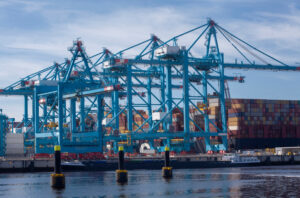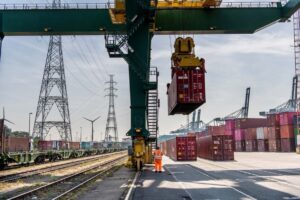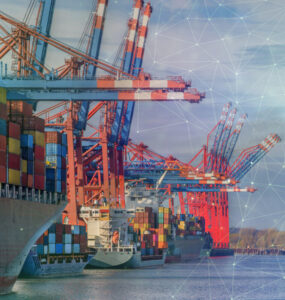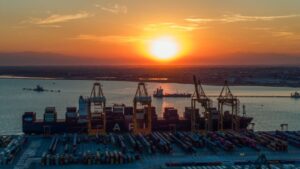A lot has changed since the beginning of the twentieth century in the way that cargo is transported, with some fundamental alterations in port equipment and the way in which shipping containers are loaded and unloaded onto ships.
According to port equipment manufacturer Kalmar, break-bulk was the traditional method of handling cargo, at least until the mid-50s when the metal shipping container was thrown into the mix and completely revolutionised the way we transport goods.
Traditionally, cargo was loaded & unloaded manually from sacks, but is now transported in much larger volumes within the metal shipping container (Source: 1914-1918.net and Business Green)
The idea of the shipping container wasn’t completely novel however, as standard-sized containers had been used by the US government during the Second World War.
Old dock side cranes are said to have been replaced by STS cranes in the mid-50s to reflect the parrelel in containerisation (Source: Flickr and Ship Management International)
It wasn’t until 1955 when an American Entrepreneur named Malcolm McClean founded his own steam-shipping company that would allow truck-trailers to be transported by ships with their cargo still inside, according to the World Shipping Council.
This old hook was the standard tool used to load & unload sacks from barges & ships. Roblog technology is the future with sensor loading technology. (Source: Ehive and Google Plus)
From then on, containers would not have to be moved manually from sack-to-ship, as was previously the case, because they could be loaded onto ships without first having to remove its entire contents.
Better utilisation of space, larger and more productive equipment, as well as larger and deeper berths are all but a few changes that have occured since the 1950's.
A still of the Port of Hamburg during the 1950s and the present day (Source: Hafen-Hamburg)
The future of cargo shipping is expected to keep on evolving at a rapid pace, with the idea that container ships could soon hold the key to sending data to and from other cargo vessels and evolve into a larger online quantum network that can offer perennial internet connectivity.
Watch Kalmar’s vision for what 2060 holds below:
In Pictures: The Past, Present and Future of Ports. (Source: Kalmar-Global (YouTube))
Watch GRID Logistics' vision for the future of container transport:












